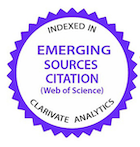Supplementation of minerals and vitamins in broiler diets: effect on performance and bone quality
DOI:
https://doi.org/10.1590/1809-6891v22e-67656Abstract
Differences in growth rate and carcass composition of broilers may require higher levels of vitamins and minerals with higher bioavailability. The aim of this trial was to supplement commercial diets for broilers with optimized levels of vitamins and with different mineral sources to assess the effect on performance, carcass yield and bone quality. A total of 1,800 Cobb Slow male broiler chicks were distributed into a 2 x 2 factorial completely randomized design (vitamin programs - optimized and commercial versus mineral sources - inorganic [sulfates] and carbo-amino-phospho-chelate, CAPC). The vitamin D3 metabolite, 25 (OH) D3, was included in the optimized vitamin premix. Birds and feed leftovers were weekly weighed. Data was subjected to statistical analysis using the GLM procedure of SAS software. Supplementing diets with a combination of optimized vitamin programs and CAPC as mineral source resulted in better feed conversion at 42 days of age (P<0.05). Supplementation with CAPC minerals resulted in a lower red index (*a) (P<0.05) in the adjacent thigh muscles and drumstick bones of broilers when thawed and roasted, indicating less bone porosity. The inclusion rates of mineral sources with higher bioavailability can be reduced, decreasing the negative impact of mineral excretion and the polluting effect on the environment.
Keywords: 25(OH)D3, black bone, organic minerals, feed conversion.
Downloads
References
UBABEF - União Brasileira de Avicultura. Carne de frango, uma unanimidade que vai do norte ao sul do Brasil. Revista Avicultura Brasil. 2012; 1:8-14.
National Research Council - NRC. Nutrient requirements of poultry. 9.ed. Washington: National Academy of Sciences; 1994.
Mota MM, Hermes RG, Araújo CSS, Pereira ASC, Ultimi NBP, Leite BGS, Araújo LF. Effects on meat quality and black bone incidence of elevated dietary vitamin levels in broiler diets challenged with aflatoxin. Animal. 2019; 13(12): 2932-2938.
Marks HL. Growth rate and feed intake of selected and nonselected broilers. Growth. 1979; 43: 80-90.
Jensen LS. Fat soluble vitamin problems in biochemical diagnosis. Athens, University of Georgia. Georgia Nutrition Council. 1974: 14.
Anderson JJB, Toverud SU. Diet and vitamin D: a review an emphasis on human function. The Journal of Nutritional Biochemistry. 1994; 5(2): 58-65.
Champe PC, Harvey RA, Ferrier DR. Bioquímica Ilustrada. Porto Alegre: Artmed; 2006
Hutton KC, Vaughn MA, Litta G, Turner J, Starkey JD. Effect of vitamin d status improvement with 25-hydroxycholecalciferol on skeletal muscle growth characteristics and satellite cell activity in broiler chickens. Journal of Animal Science. 2014; 92(8): 3291-3299.
Vignale K, Greene ES, Caldas JV, England JA, Boonsinchai N, Sodsee P, et al. 25-hydroxycholecalciferol enhances male broiler breast meat yield through the mtor pathway. The Journal of Nutrition. 2015; 145: 855–863.
Garcia AFQM, Murakami A E, Duarte CRA, Rojas ICO, Picoli KP, Puzotti M M. Use of vitamin D3 and its metabolites in broiler chicken feed on performance, bone parameters and meat quality. Asian-Australasian Journal of Animal Sciences. 2013; 26: 408-415.
Applegate TJ, Angel TJ, Angel R. Los metabolites de la vitamin D son prometedores para uso en dietas avícolas. In: Vademécum avícola. Santiago: Centrovet; 2005.
Sanda ME, Ezeibe COM, Anene B.M. Effects of Vitamins A, C and E and Selenium on Immune Response of Broilers to Newcastle Disease (ND) Vaccine. Journal of Agriculture and Veterinary Science. 2015; 8:13-15.
Vieira R, Ferket P, Malheiros R, Hannas M, Crivellari R, Moraes V, Elliott S. Feeding low dietary levels of organic trace minerals improves broiler performance and reduces excretion of minerals in litter. British Poultry Science. 2020; 61(5): 574-582.
Bao YM, Choct M, IJI P. A effect of organically complexed copper, iron, manganese, and zinc on broiler performance, mineral excretion, and ac- cumulation in tissues. Journal of Applied Poultry Resesearch. 2007: 16448-455.
. Savaram Venkata RR, Bhukya P, Raju MVLN, Ullengala R. Effect of Dietary Supplementation of Organic Trace Minerals at Reduced Concentrations on Performance, Bone Mineralization, and Antioxidant Variables in Broiler Chicken Reared in Two Different Seasons in a Tropical Region. Biological trace element research. 2020; doi: 10.1007/s12011-020-02481. PMID: 33216320.
Khatun A, Chowdhury SD, Roy BC, Dey B, Haque A, Chandran B. Comparative effects of inorganic and three forms of organic trace minerals on growth performance, carcass traits, immunity, and profitability of broilers. Journal of Advanced Veterinary and Animal Research. 2019; 6(1): 66-73.
Baloch Z, Yasmeen N, Pasha TN. Effect of replacing inorganic with organic trace minerals on growth performance, carcass characteristics and chemical composition of broiler thigh meat. African Journal of. Agricultural Research. 2017; 12(18):1570–1575.
Sakomura NK, Rostagno HS. Métodos de pesquisa em nutrição de monogástricos. Jaboticabal: Funep; 2007.
Seedor JG, Quarraccio HH, Thompson DD. The biophosphonate alendronate (mk-217) inhibits bone loss due to ovariectomy in rats. Journal of Bone and Mineral Research. 1991; 6(4): 339-346.
Whitehead CC, Mccormack HA, Mcteir I, Fleming R H. The maximum legal limit for vitamin D3 in broiler diets may need to be increased. British Poultry Science. 2004; 45: 24-26.
Nelder J, Wedderman R. Generalized linear models. Journal of the Royal Statistical Society: Series A (General).1972; 135: 370–384.
Sugiharto S, Isroli I, Yudiarti T, Widiastuti E. The effect of supplementation of multistrain probiotic preparation in combination with vitamins and minerals to the basal diet on the growth performance, carcass traits, and physiological response of broilers. Veterinary World. 2018; 11(2): 240-24.
Vaz RGMV, Oliveira RF, Donzele JL, Albino LFT, Sirqueira JC, Oliveira WP, et al. 2014. Níveis de vitamin em rações para frangos de corte mantidos em ambiente de alta temperatura no período de 1 a 42 dias de idade. Bioscience Journal. 2014; 30(5): 1522-1528.
Habibian M, Ghazi S, Mohammad MM. Effects of dietary selenium and vitamin e on growth performance, meat yield, and selenium content and lipid oxidation of breast meat of broilers reared under heat stress. Biological Trace Element Research. 2016; 169: 142–152.
Funari Júnior P, Albuquerque R, Alves FR, Murarolli MDA, Trindade Neto MA, Silva EM. Diferentes fontes e níveis de selênio sobre o desempenho de frangos de corte. Brazilian Journal of Veterinary Research and Animal Science. 2010; 47(5): 380-384.
Carvalho GB, Lopes JB, Silva SRG, Dourado lRB, Miranda DFH, Costa FAL. Desempenho, morfometria duodenal e histopatologia do fígado de frangos de corte alimentados com dietas contendo diferentes níveis de selênio orgânico em condições de estresse calórico. Revista Brasileira de Saúde e Produção Animal. 2015; 16(2): 365-376.
Świątkiewicz S, Arczewska-Włosek A, & Jozefiak D. The efficacy of organic minerals in poultry nutrition: review and implications of recent studies. World's Poultry Science Journal. 2014; 70(3): 475-486.
Gai ZT, Toledo GSP, Costa PC, Lopes JM, Visentini P, Kloeckner PE. Efeito de níveis alto, médio e baixo das vitamins A, E, piridoxina (B6), ácido fólico e biotina no desempenho de frangos de corte de 1-42 dias. Revista Brasileira de Zootecnia. 1997; 26(2): 304-309.
Baldo GAA, Almeida Paz ICL, Alves MCF, Naas IA, Garcia RG, Caldara FR, Gavilan CWS. Black bone syndrome in chicken meat. Brazilian Journal of Poultry Science. 2013; 15(2): 317–322.
Liu R, Jin C, Wang Z, Wang Z, Wang J, Wang L. Effects of manganese deficiency on the microstructure of proximal tibia and OPG/RANKL gene expression in chicks. Veterinary Research Communications. 2015; 39(1): 31-37, 2015.
Whitehead C. The black bone syndrome in broilers. International Hatchery Practice. 2009; 23(8): 7-9.
Korver D. Reducing the incidence of black bone. World Poultry Science. 2010; 26: 36-38.
Published
How to Cite
Issue
Section
License
Copyright (c) 2021 CIÊNCIA ANIMAL BRASILEIRA (Brazilian Animal Science)

This work is licensed under a Creative Commons Attribution 4.0 International License.
Authors who publish with this journal agree to the following terms:
- Authors retain copyright and grant the journal right of first publication with the work simultaneously licensed under a Creative Commons Attribution License that allows others to share the work with an acknowledgement of the work's authorship and initial publication in this journal.
- Authors are able to enter into separate, additional contractual arrangements for the non-exclusive distribution of the journal's published version of the work (e.g., post it to an institutional repository or publish it in a book), with an acknowledgement of its initial publication in this journal.
- Authors are permitted and encouraged to post their work online (e.g. in institutional repositories or on their website) prior to and during the submission process, as it can lead to productive exchanges, as well as earlier and greater citation of published work (See The Effect of Open Access).































